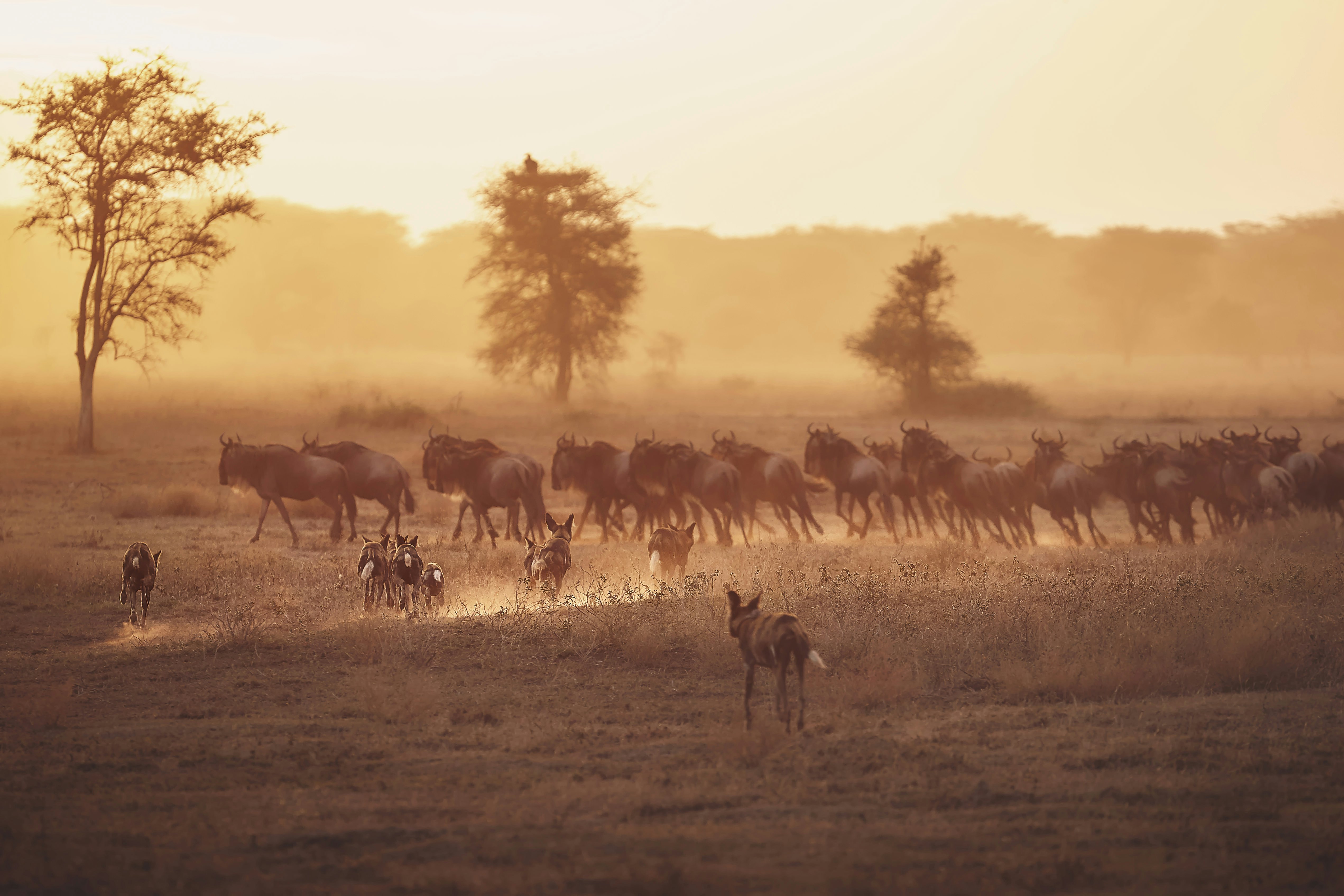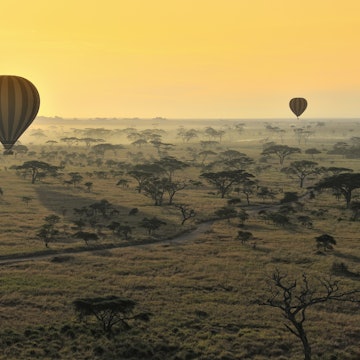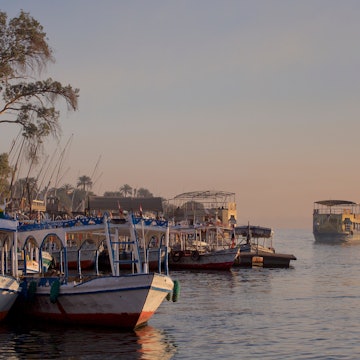
The Serengeti's Great Migration: the world's ultimate wildlife spectacle
Jan 8, 2026 • 11 min read

The Great Migration across Serengeti National Park, Tanzania. Photostock-Israel/Getty Images
Often billed as the world’s ultimate wildlife spectacle, the Great Migration of wildebeest and zebra takes place annually across the plains of East Africa; Amanda Canning travels to Tanzania to catch up with the herds.
We’ve not long left our camp on the Namiri Plains in northern Tanzania before my guide, Noel Akyoo, spots a flurry of activity in the distance and bumps the Land Cruiser in its direction. A group of around 20 hyenas is gathered around the rapidly disintegrating carcass of a wildebeest. In a tree behind them, a tawny eagle pulls at a rib held in its yellow talons. The Great Migration of wildebeest and zebra across the Serengeti has its winners, and its losers.
I’ve timed my visit to coincide with Africa's most famous migration – the annual 1900km journey of 1.5 million wildebeest and 250,000 zebra between Serengeti National Park in Tanzania and Masai Mara National Park in Kenya, following the rains and the grasses that spring up in their wake. It's a migration that takes in two of Africa's best national parks for wildlife safaris.
The migration is a bonanza for any creature that counts these herbivores as dinner. For the lions, cheetahs, leopards, hyenas and wild dogs here, hunting at this time of year requires as much effort as picking a dish from the conveyor belt at Yo! Sushi. It must be, I assume, fairly easy for a human to track down these migrants, too. But that's where I'm wrong.

Tracking the Serengeti's elusive herds
I see plenty of evidence of deceased wildebeest, and small groups of living wildebeest idling about or plodding to some unseen destination across the plains, but I expected to be overwhelmed by thousands upon thousands of the beasts, thundering past in clouds of dust.
Noel moves the Land Cruiser off and we trundle along rutted tracks. "We will try and find them," he says, "But the migration was early this year. The herds are already moving south to give birth in the woodlands." He laughs. "That is the beauty of the Serengeti – you never know what you’re going to come across."
What we do come across on that first day is extraordinary enough. I get to enjoy the wonder of animals not generally on people’s wildlife checklists: the bright flashes of superb starlings; a long-horned beetle slowly eating a yellow fever tree from the inside out; the pointy ears of a caracal hiding (badly) in the long grass.

And there are the big-hitters too. Off-limits for over 20 years in an effort to increase cheetah numbers, the Namiri Plains area is today a stunning spot to encounter these graceful big cats. We spot several through the day, their long, thin bodies stretched out in the dust or pulled upright on termite mounds, alert for prey.
There was an embarrassment of lions too, lolling about in the grass or cooling themselves on the rocks. Tiny cubs tumbled about like furry drunks as the pride males consolidated their standing as the rock stars of the savannah, manes billowing in the wind and backlit by the setting sun.
We have the rare privilege of spotting a leopard, too, an elegant female tucked into the crook of a tree. Returning to camp, though, I can’t help but be nagged by the thought that this trip may represent my only chance to experience one of the world’s greatest wildlife spectacles, and it’s happening somewhere else.
Noel is unconcerned. "Every day is different," he says, clambering out of the vehicle. "There is always tomorrow."

Seeing the Serengeti from above
The next day starts beneath a billion stars. I am standing outside my tent, watching two shooting stars whoosh across the inky sky, when the deep guttural rumble of a lion reverberates through the darkness. It is a sound of such primordial resonance that my entire body seems to vibrate to it.
With dawn approaching, the lion’s time to hunt for wildlife is over, and it’s my turn to take a shift. The day has brought a change in approach – if we can’t find the migration from the ground, perhaps we’ll have better luck from the sky.
The last stars are fading as our hot-air balloon slides into the sky. For the first few minutes, we skim across the ground, past trotting warthogs and strutting ostriches, then suddenly we are a hundred meters up, with all of the Serengeti laid out beneath us. It is a vast beige sea, dotted with acacias and granite outcrops. The Seronera River wiggles through it, with the shiny lumps of a hippo pod visible in its shallows.

Pulling on the burner, the balloon's captain, Mohamed Masud, studies the ground beneath us. "You can see how busy this area gets in migration time," he says. "There are so many trails." He's right. There are countless pale lines cut into the ground by millions of hooves, left by animals that have passed this way for a million years.
There is little sign of the herds this morning, though. "We don’t really know where they are now," continues Mohamed. "The rain has not come, so the migration is really spread out. Maybe if it rains, it will come." Such is the nature of safaris.
However, the grazing animals that live in this patch of the Serengeti year-round are out in force. Giraffes bob across the savanna, galloping for cover on gangly legs as we sail overhead. As I peer after them, I spy several groups of animals standing unmoving among the trees. They're wildebeest – not thousands, not thundering past in clouds of dust, but wildebeest all the same.

Catching up with the herd, finally!
Back on the ground, we head towards the woods and almost immediately catch up with our target. A long line of several hundred wildebeest is plodding towards the river. They need to cross a road to join the huddles I’d seen from the balloon, but none of them seem willing to make the first move.
"The thing about wildebeest," says Noel, "is that they don’t have a leader. If the one in front changes direction, they all follow." We watch as the wildebeest make slow, almost comedic progress towards their goal. One animal bolts, and a hundred animals bolt. One stops, and they all stop. It takes a good two hours of confused milling before they finally muster up the courage to cross.
As we lurch back to camp, triumphant after the first, small taste of the migration, I turn and take a last look at the herd. Behind them, fat, dark clouds are starting to bubble on the horizon. The rains are coming, and not a moment too soon.

The full Great Migration experience
If the migration is heading south, then so must we. It’s a short bounce in a light aircraft to the next camp in the southern Serengeti. From the air, it’s clear we’re catching up with the wildebeest – far below, innumerable black dots are moving steadily in the same direction.
From the airstrip, my guide, Charles Joseph, takes us straight off to a herd he’s been following for a few days. Thousands of wildebeest, and the odd zebra, are plowing across the plains, a huge billowing cloud of dust rising overhead. The line is so long we can’t see the front or end of it. "This group has been moving back and forth for nearly a week," says Charles. "They’re looking for water."
We are not the only ones watching. All around the herd, predators lurk. Charles spies a cheetah and her cub sheltering behind a whistling thorn acacia. "Cheetahs are right down the pecking order of predators," says Charles, as globs of rain splatter into the dust. "They can’t compete with a lion or a wild dog, so their only advantage is to hunt in daytime."

We spend the next few hours tracking the mother as she locks sight on her prey and readies to attack, but is spotted and thwarted. She has to travel several miles before she finally gets her chance – two gazelles walk past, oblivious, and she chases one down with a sudden explosive burst of force.
Mother and cub take turns to feed, one constantly watching out for scavengers. "You can’t relax for a second out here," says Charles as three vultures land nearby. "The hyenas won’t be long. They’ll have seen the vultures circling and will follow."
I’ve been so transfixed that it’s only when the cheetahs flop full-bellied into the grass that I become aware of the life now brimming on the plains. There are thousands upon thousands of wildebeest, behind, in front, to the side, trudging ever onward.

Wild dogs – the Serengeti's master hunters
Overnight, our camp has already become a motorway for the migration, but we drive on for a few more hours. As we crest the Maru Hills, there before us is the Promised Land for grazing creatures. There is not an inch of the earth not occupied by a wildebeest or zebra, baboon or elephant. The grass is long and green – if I were a wildebeest, I’d walk a thousand miles for this too.
Returning home in the warm glow of the setting sun, we’re drawn to a commotion close to camp. Thousands of wildebeest are stampeding, and we soon see why – wild dogs. A pack is herding the animals into groups, assessing which to target.
As the sky darkens, a juvenile is forced out of the herd, and the wild dogs commit to the chase. One dog gets hold of a leg and pulls the hapless animal down, then the pack descends. "They’re super hunters, one of the best predators in the world," says Charles. "Once they have made a decision to hunt, they do not stop until they have their kill."
I return to camp to find the wildebeest and zebra still passing through. Naturally, the animals are marching solemnly in the opposite direction they had been traveling that morning, and I ponder the powerful instincts – the need for food and water, and the fear of predators – that drive the Great Migration. Ultimately, the herds know where they’re going, but they get there when they get there...

When to see the Great Migration in the Serengeti
The migrating herds follow the same path each year, traipsing back and forth between the Serengeti in Tanzania and the Masai Mara in Kenya. However, the Great Migration does not follow a strict schedule, and its precise location in any one month cannot be easily predicted.
Factors such as an early or late rainy season will affect when the 1.5 million wildebeest and 250,000 zebra start to move. If you’re booking ahead – always a good idea for this destination – it’s wise to choose a safari operator who will allow you to change your itinerary depending on the herds’ progress.
However, you can rely on the herds starting to move north from April or May, and beginning to turn south from November or December. Here is a rough schedule of the key events of the Great Migration.
January to March: Wildebeest and zebras graze and calve in the southern Serengeti
April to May: Herds start to move north, passing through the central Serengeti
June to August: The herds cross the crocodile- and hippo-infested Mara River and head into the Masai Mara in Kenya
September to October: The great herds pause to graze in the Masai Mara
November to December: The herds turn south, and the cycle begins again
Getting to and around the Serengeti
It’s a two-stop journey to reach the Serengeti. Most overseas visitors travel via Nairobi, Istanbul or Paris to reach Kilimanjaro International Airport in Tanzania. From there, you'll need to catch a light aircraft to one of the airstrips dotted around the Serengeti; your lodge will advise which one is most convenient.
Domestic flights and accommodation in safari lodges are typically included in your safari package. Light aircraft act like buses in the Serengeti, picking people up from one part of the park and depositing them elsewhere, likely with stops on the way to pick up other passengers. Lodges will arrange to collect you from the airstrip on each step of your journey.
Need to know
There are a few practicalities to consider on a trip to the Serengeti.
Check the travel advisory notices for Tanzania from your home government before you travel.
You’ll need an up-to-date yellow fever vaccination to enter Tanzania. Don’t forget to bring your certificate – you’ll need to show it at the airport on arrival.
You’ll want a course of anti-malarial drugs to cover your stay; also bring plenty of mosquito repellent.
The plains can be dusty, particularly on windy days. Bring a light scarf to cover your face. You’ll also need a jumper or jacket for cooler morning game drives.
Your guide will likely have a pair of binoculars you can borrow, but it’s worth bringing your own. A pair with 8x or 10x magnification will do the trick.
Don’t wear bright or patterned clothing; it will make you stand out to all animals within a mile radius. Plain grey, green or beige clothes are best.
Amanda Canning traveled to Tanzania with support from Audley Travel. Lonely Planet contributors do not accept freebies in exchange for positive coverage.















